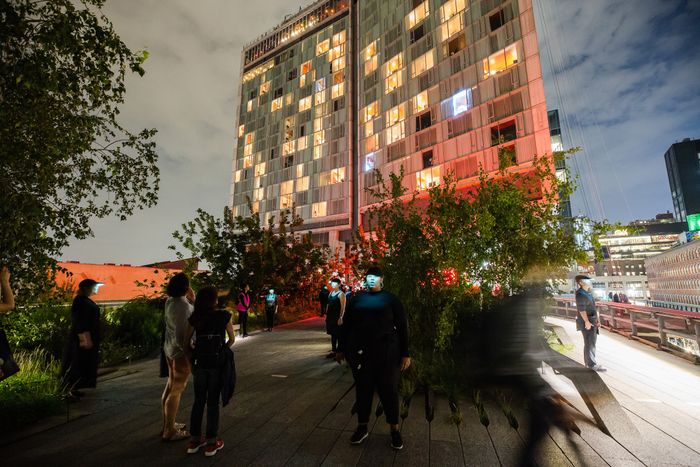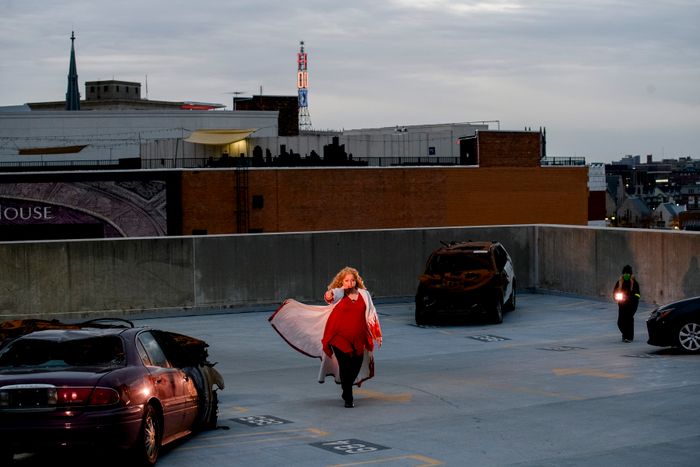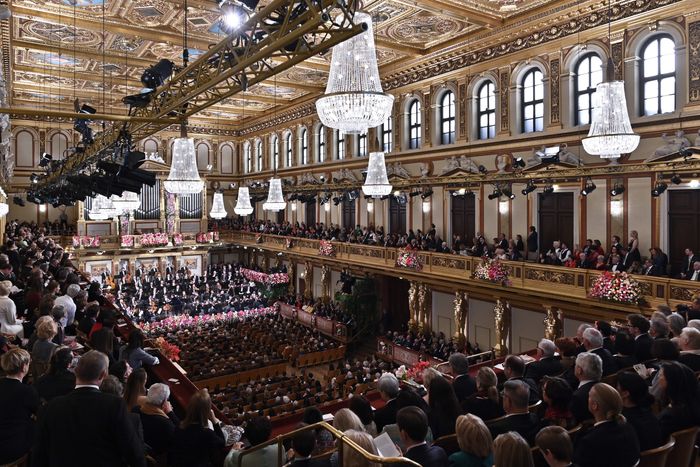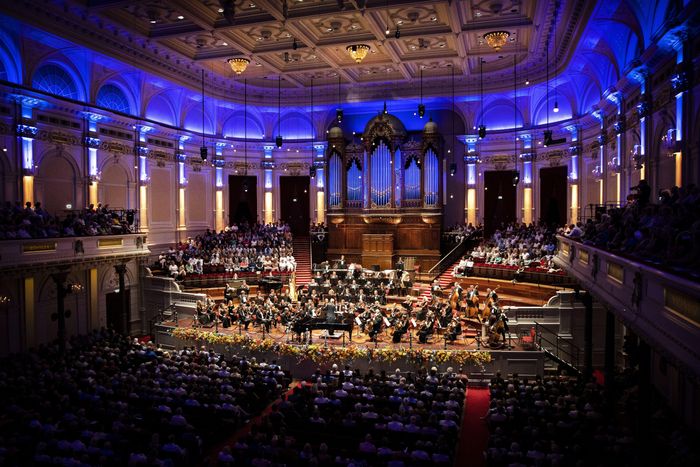Why Do Concert Halls Still Matter?
Carnegie Hall.
Photo: Noam Galai/Getty Images
A concert begins with a series of reassuring rituals. First, the quick clip across the plaza, the flourishing of tickets, the awkward jostle of knees and coats. Then comes the hush between the audience’s hum and the first downbeat, the instant in which everyone present can legitimately hope for a miracle. What unfolds next is both foreordained and unpredictable: a performance superficially the same as any other rendition of the same score, but also profoundly different — wondrous, perhaps, or merely rote. Even when we know how the music will go, we don’t know how it will make us react.
As a society, we value that margin of uncertainty. We feel so strongly about preserving it that we erect large, expensive buildings for that purpose. A concert hall is a facility designed to generate indelible memories. This is where architects come in. Music can happen in a shed or a subway station. A violinist remains just as talented in her bedroom as on the stage of Carnegie Hall. But a great hall lies at the convergence of architecture, acoustics, and music. For the audience, the pleasures of seeing, hearing, and inhabiting a beautiful space merge in multisensory intensity. How high the ceilings rise, how intricately the walls curve and fold, how far the balconies extend, how steeply the floors are raked, how many seats fill how much square footage and what material they’re upholstered in — all these separately humdrum factors conspire to loft a crescendo so that it reaches the ear and hums through the body’s wires. We ask homes to give us comfort, offices to coax us into productivity, hospitals to help us heal; what we demand of concert halls is a regular opportunity to be moved.
I have been lucky to step across the gap between routine and revelation many times, to find myself suddenly enveloped in music instead of merely listening to it. It happened one evening in September 2001 when Kurt Masur led the New York Philharmonic in Brahms’s Ein Deutsches Requiem in the hall that was then still named for Avery Fisher and would later be rebaptized in honor of David Geffen. New York had gone quiet since 9/11. Performances were canceled. Radios were tuned to sober news. Stores and public spaces muted their PAs, and the constant, global clang of tunes that filled the city’s airwaves was attenuated. Inside the hall, the audience took care to still its usual soundtrack of muttering, shuffling, coughing, and snoring.
The Philharmonic answered that attentive silence with exquisite music. Brahms’s Requiem can be a lofty, brooding work, but now it had a new resonance and a dual purpose of commemoration and consolation. Masur and the orchestra mined the score for all its trembling fire, giving it an urgency I had never registered before. At the end of the performance, the audience held its applause, letting the music hang in the air. As we filed out of the hall in silence, it was as if the grief and shock of those days were spilling into the streets along with us. Afterwards, on the subway, a chorister told me: “The meaning of this piece has changed. It’s not just about abstract death.” But here’s what hadn’t changed: For that work to overwhelm that audience on that night, we still needed those old essential standbys — a chorus, an orchestra, and a concert hall.
The open-ended possibility of revelation is an expensive delight, especially when we look for it in symphonic music. Renovating David Geffen Hall in New York cost well over half a billion dollars, and that’s for a venue that already existed. The fact that Lincoln Center and the New York Philharmonic could raise such a fortune with relative ease, even during a pandemic, speaks to how highly the city values the act of coming together to hear natural, unamplified sounds milliseconds after players have produced them. That close and unmediated relationship between performers and listeners has been fundamental to music since a cave dweller first tapped two rocks together and a companion howled along. And yet, today, most humans consume most music most of the time as a series of electronic audio signals, often while absorbed in solitude. The concert hall has become a deluxe countercultural artifact.
The phone rings, the subway busker hollers, the preacher sermonizes, the garbage truck backs up, the microwave announces that dinner is hot — and every one of those ordinary acoustic events, boosted by digital technology, clamors for our attention, mostly with little success. Trying to eliminate all the electronic dings, blurbs, and beeps from your sound world, or go more than a few hours without hearing an engine, could become an all-consuming quest.
Such a catalog of noises doesn’t even include the kind so many of us inject directly into our ear canals. Since the Walkman’s heyday in the 1980s, music has dissolved from a collective medium into a scattering of private soundtracks. Instead of giving form to shared rituals or gathering people in a community of taste, each of us gets to choose what sounds accompany our passage through the world, unheard by everybody else. This is a profound change in the way humans manage one of the five senses.
In the world our bodies inhabit, hearing orients us, helping us to understand distance and gauge direction. Think how surreal it would feel to walk into a cozy, carpeted den and hear voices ringing as if in a vast stone cathedral. Or to stand across a trafficked street from someone and be able to converse in a whisper. And yet the ubiquity of headphones and earbuds has hijacked that fundamental aspect of perception, scrambling our relationship to landscape and architecture. Jog along a quiet park path and the sounds in your head may place you in a screaming arena. When you walk across a vast parking lot, the playlist in your pocket offers you a singer-songwriter’s intimate fireside murmurs. Get into a car, and the stereo lobs you into the center of an opera house or a dance club. Physical space has become completely disconnected from acoustic space.
In this new world of electronic signals piped directly into the brain, the concert hall has become a sonic nature preserve, a haven of unamplified vibrations. There, waves produced by muscle and breath — the scrape of horsehair on string, or a player’s exhalation rushing into a metal tube — careen from wall to wall, acquiring character from every surface, then beat against cartilage and vibrate against skin. It’s surprising, really, that such a place still exists, or that new ones get built, when music is so ubiquitous and virtually free. Why pay for a babysitter, tolls, parking, and possibly a mediocre and overpriced dinner when you can mainline a personalized program while lying in bed? Why tolerate the presence of other listeners, with their mumbling and their germs? Or, to put the question another way: Why do concert halls still matter?
One obvious but insufficient response is that music — unamplified music, anyway — sounds better live: The qualitative difference between an in-person performance and a high-end digital reproduction justifies the expense, the time, and the carbon emissions involved in building an acoustically ideal room. Reconstructing Geffen Hall was predicated on achieving excellent acoustics; without that promise, the project would never have gone forward. Architects and acousticians take this responsibility seriously, calculating the dispersal of sound waves, evaluating the properties of materials, and finding precise mathematical definitions for intuitive descriptors like clarity, balance, and warmth. And yet in the world beyond those carefully sculpted walls, most of us treat sound quality as a frill. Mostly, we listen to crudely compressed files squeezed like toothpaste through tinny speakers or listen over the clatter of a treadmill, the thrum of an engine, or the chatter of crowds.
Today we consume music—in all idioms, including the most traditional—privately and publicly, communally and solo, from the subway to the Philharmonie Berlin. Clockwise from top left: Photo: ShutterstockPhoto: Piotr Piatrouski/ShutterstockPhoto: Martin Parr/Magnum PhotosPhoto: Berk Ozdemir/Shutterstock
Today we consume music—in all idioms, including the most traditional—privately and publicly, communally and solo, from the subway to the Philharmonie …
Today we consume music—in all idioms, including the most traditional—privately and publicly, communally and solo, from the subway to the Philharmonie Berlin. From top: Photo: ShutterstockPhoto: Piotr Piatrouski/ShutterstockPhoto: Martin Parr/Magnum PhotosPhoto: Berk Ozdemir/Shutterstock
But there’s a more panoramic answer to the riddle of why we continue to value the concert hall. A room that’s consecrated to music is one where people come together, sit in quiet communion, listen rather than shout, and focus for a couple of hours instead of getting peppered with notifications. It’s an antidote to the Age of Distraction — a place where we come to unhook, quiet the mind, and set aside the outside world. (At least if audience members turn off their phones.) Such an institution is one of the few sacramental spaces we have outside of explicitly religious buildings. At a time where we can be pinged round the clock, even in a funeral home, on a mountaintop, or the bath, in a concert we can truly be unavailable.
When the pandemic shut down nearly all collective activities, the digital world stepped up with a literally sanitized version of musical life. The pianist Igor Levit broadcast recitals from his living room. Orchestra musicians recorded their parts in separate video sessions, so that they could be artificially assembled into an onscreen grid and the result beamed out to isolated millions. These experiments, though invigorating, also made it impossible to take for granted the old analog forms of togetherness and shared experience. When the emergency abated, the concert hall seemed suddenly strange and wonderful again, and a new question emerged about live music: Is it worth the risk?
The Musikverein in Vienna.
Photo: Herbert Neubauer/AFP/Getty Images
The history of music is inseparable from the narrative of places where people gather. The circle of light thrown by a campfire, the tarpaper shack by the side of a road, the stone cathedral, the gilded ballroom — each of these shaped the way music was made and heard. In the antebellum South, the slaves who bent over rows of cotton shouted their songs responsively, because that was the only way to launch the comfort of human contact across an open field. In medieval Europe, villagers and monks who congregated in great cold churches chanted their prayers, also responsively, because that was how the words of their faith could waft into the vaults and acquire divine resonance before enveloping the faithful in reverberant song.
Architecture is always a musical tool: Händel wrote differently depending on whether he was supplying music for a duke’s chamber, a public theater, or a barge on the river Thames. And so long as a link between music and space existed, the relationships between listeners were always part of music’s meaning, too. The term chamber music could once have been defined as “a composition intended to be performed in a room exactly large enough to contain all one’s friends.” In the nineteenth century, consumers bought sheet music to play at home, but if a work proved too vast or complex for a parlor spinet, orchestral performances provided the only way to absorb the period’s most crucial art form — and that required a container bigger even than a rich person’s home.
But not that much bigger. It’s a measure of Beethoven’s stature in 1824 that he was willing to splurge on renting the large and luxurious Imperial Court Theater at the Kärntnertor in Vienna for the premiere of his choral symphony. The warm and stuffy auditorium held about one thousand people, jammed in hip-to-hip and knee-to-spine, according to early nineteenth-century standards of comfort. A modern room of similar dimensions would likely accommodate just six hundred or so. If it still existed, the Kärntnertor would likely function as a lovely recital hall.
The size of the rooms that Beethoven wrote for matters because he was so intent on bursting through their walls. In his more cosmic symphonies, he battered listeners with violent fortes and engineered crescendos whose throbbing, physical power was amplified by the closeness of even the most expansive hall. His music did battle with architecture, which stood in nicely for mortality, injustice, society, and fate. He was determined to vanquish them all.
The audiences at those concerts would strike us as boorish. They talked and smoked, yelled catcalls, and applauded whenever they wanted. Beethoven would hardly recognize our concert-going culture, in which people sit in reverent silence, then clap politely and go home. But that doesn’t mean that his audiences didn’t care. In fact, their own experience of playing and writing music made them deeply engaged. They recognized when a convention was being stretched or overturned, and they communicated that awareness.
After Beethoven died in 1827, musical Europe paid its demigod homage by building ever more generous halls to enshrine his music — halls that neutralized its trapped, cage-rattling ferocity. The first dedicated concert space in London was St. James’s Hall, built in 1858 with a seating capacity of two thousand. Vienna’s Musikverein opened in 1870, Carnegie Hall in 1891. Beethoven’s music acquired its nimbus of divinity and settled into these capacious Xanadus. By 1885, Johannes Brahms composed with the understanding that his symphonies must be elastic, able to squeeze into a small palace theater or expand for a great public event. That year, an ensemble of forty-nine players performed the world premiere of his Fourth Symphony in the German provincial city of Meiningen. Two weeks later, the Vienna Philharmonic played the same piece at the Musikverein with a force more than twice as large.
The Meiningen and Vienna versions were, in a sense, two different pieces. At Meiningen, the relatively small ensemble would have brought out the intricate counterpoint, making the symphony sound like chamber music at a large scale. The Vienna performance would have emphasized grandeur and drama. Brahms’s genius was to make a piece that could adapt to its surroundings. The size of the hall mattered enormously to Brahms’s music in the 1880s, and it remained crucial a century later, when I recall hearing the composer and conductor Leon Kirchner lead a student performance of the First Symphony in the relatively intimate confines of Jordan Hall in Boston. He gave it the layered intricacy of a string quartet, the usually barely noticeable violas unspooling a luminous ribbon of sound that made the score glow from within. Could he have achieved the same effect in a 1970s multiuse concrete hall with a capacity of 3,000? I doubt it.
The marriage of space and musical inspiration produces such powerful experiences that, sometimes, the hall becomes a shrine. In his book Time’s Echo, the critic Jeremy Eichler cites Stefan Zweig’s account of the final performance in Bösendorfer Hall just days before it was scheduled to be demolished in 1913. The room, Zweig recalled, “had the resonance of an old violin, and it was a sacred place to music lovers because Chopin and Brahms, Liszt and Rubinstein had given concerts there … When the last bars of Beethoven died away, played better than ever by the Rosé Quartet, none of the audience left their seats. We shouted and applauded, some of the women were sobbing with emotion, no one was willing to admit that this was goodbye.”
Adieux like that are a constant in urban life, where the unsentimental pace of change does battle with memory. In 1960, Carnegie Hall dodged demolition, and in its defense, the violinist Isaac Stern invoked the spirits of Tchaikovsky and Horowitz, whose presence he claimed to sense in its walls. Nearly four decades later, CBGB, the stale-air firetrap on New York’s Lower East Side that launched the Ramones and the Talking Heads, shut down. Devotees, some of whom hadn’t been there in decades, mourned the site of their youthful abandon, a place where the sweat was fresh, the floor sticky, and the vibe gritty and manic.
Bösendorfer Hall was compact, but the intensity of feeling that Zweig described could also swell to fit a much vaster space. In the late nineteenth century, the concert hall had become large enough to contain any concept of musical spaciousness. Like the present-day recording studio, it had virtually no inherent limitations. Mahler kept packing the stage with more and more performers for each opus — a trajectory that culminated in his Eighth Symphony, known as “Symphony of a Thousand.” Like Beethoven, he pounded at the limits of architecture, making rafters quiver and filling every inch with vibrating air. Unlike Beethoven, he defied architects even far into the future to outdo his sense of grandeur. I have never heard a Mahler symphony in a hall so vast that it made the music sound small.
The bigger the room, the more crucial the acoustics. When players and audience are seated close enough for a murmured conversation, music tends to sound fine, too. At a Mahlerian scale, though, details and nuance regularly get lost in a clangorous storm. The contemporary acoustician’s toolkit has brought a measure of predictability to the architecture of music, and the likelihood of disaster diminished. But chance still has its say, thank goodness. A thousand minds imbibing the same performance at the same time will hear it in a thousand different ways. That’s the power of live performance. A great hall exists not just to please the ears, but to serve as a vehicle for a sensual, full-body experience and, just as important, the infinitely varied memories of that experience.
This subjectivity leads to the vaguely derogatory term “psychoacoustics.” (Or, as one orchestra-world mandarin once termed it, “acoustics: the science of hearsay.”) The term implies that we don’t really hear what we think we do, that people are easily distracted from pure music. To keep everyone’s mind trained on his creations, Wagner designed his own theater in the Bavarian town of Bayreuth. He plunged audiences in darkness and placed the orchestra beneath the stage so that music wafted to the ears from an unseen source. He needed an aura of mystery and absorption in which the real world disappeared, making room for the one he had created. Today’s opera houses continue to build on that model and, at times, subvert it. When the director Simon McBurney raised the orchestra into view for his recent production of Die Zauberflöte at the Metropolitan Opera, the players became part of the cast. The directorial effect changed the musical balance — or perhaps only the perception of that balance. Concert hall designers often pursue a different strategy, privileging intimacy and approximate egalitarianism over the architectural expression of status. In the ideal modern venue, there should be no bad seats or royal boxes. Vineyard seating, in-the-round configurations, and a maximum capacity of roughly 2,200 all bring listeners closer to the source and to one another.


David Lang’s Mile-Long Opera (performed on the High Line) and Michigan Opera Theatre’s Twilight: Gods (a Wagner reinterpretation in a parking garage) turn unexpected spaces into ad hoc halls. From left: Photo: Liz LigonPhoto: Brittany Greeson/The New York Times/Redux
David Lang’s Mile-Long Opera (performed on the High Line) and Michigan Opera Theatre’s Twilight: Gods (a Wagner reinterpretation in a parking garage) …
David Lang’s Mile-Long Opera (performed on the High Line) and Michigan Opera Theatre’s Twilight: Gods (a Wagner reinterpretation in a parking garage) turn unexpected spaces into ad hoc halls. From top: Photo: Liz LigonPhoto: Brittany Greeson/The New York Times/Redux
Today’s best concert halls, with their clear sight lines and crystalline acoustics, have a paradoxical new challenge: to compete with the very culture they foster. The classical music establishment strives for a flawless global consistency. Tonight’s recital in Amsterdam should sound just as smooth and glossy as last night’s version in Hamburg or next week’s in Shanghai. But if the concert is merely a product, manufactured to avoid surprises, then a reproduction is practically as good as the original. Maybe that’s why the concert hall and opera house had a relatively brief and never secure monopoly over musical life. In the twentieth century, innovative artists chafed against high ticket prices and the constraints of tradition: players facing one way and the audience facing the other, for example, and a whole range of unspoken commandments. (Clap later, not now! No texting! No playing air violin!) The search for the memorable one-off, the extraordinary event that wouldn’t simply fade into the routines of concert life, led adventurous musicians to find spaces that were special precisely because they weren’t designed for music. Segments of the twentieth century’s avant-garde drifted off to lofts and galleries, where the rent was low, wine was cheap, and decorum nonexistent.
I have had some superb experiences in these non-halls. I’ve slouched on the floor of the Park Avenue Armory’s immense drill hall to absorb Stockhausen’s Oktophonie. I’ve heard John Luther Adams’s Inuksuit while lying on the high prairie of a Montana ranch, where cowboys ambled up on horseback to listen in and musicians wandered off toward the distant peaks. I’ve walked up the High Line in New York as singers stationed along the way performed David Lang’s Mile-Long Opera. And I’ve wished I had caught other blowouts, many staged by the director Yuval Sharon: Christopher Cerrone’s Invisible Cities delivered to unsuspecting passengers at L.A.’s Union Station, Michigan Opera Theatre’s pandemic-period Götterdämmerung in the company’s parking garage. But I’ve found that each of these excursions has wound up leading me back to the home where a symphony orchestra dwells, plays best, and sounds most vibrant. Each time I return, I appreciate the complexity of a well-designed hall, the interlocking of parts, many of them invisible, all marshalled to the same goal. Even an alert audience member sitting in pleasingly lit, warmly wood-clad auditorium may forget about the freight elevators and silent climate control, the dressing rooms and timpani storage, the lifts that position the risers and the piano and the podium — the whole elaborate gearworks that makes catharsis possible. Spontaneity must be planned.
In Time’s Echo, Eichler describes the premiere of Shostakovich’s Thirteenth Symphony in the Great Hall of the Moscow Conservatory. The work is a musical memorial to the Jews whom Hitler’s forces murdered en masse and dumped into the ravine of Babi Yar in Kyiv in 1941 — a horror that the Soviet regime downplayed as it engaged in its own anti-Semitic campaigns. The moment was supercharged by years of official denial that the massacre had even taken place; by Shostakovich’s decades of struggle with a capricious regime; by the Cold War’s hopes and hysterias; and by a sequence of fitful cultural thaws that had raised and crushed hopes for a more liberal Soviet Union. But for all those currents to crash together in a great spume of music and emotion on December 18, 1962, artists and audiences required a special room, the basic apparatus of togetherness in Europe’s musical tradition. “After the Babi Yar movement ended,” Eichler recounts, “spontaneous applause and shouting erupted in the hall, so much so that the conductor Kirill Kondrashin, fearing the cheers would be perceived as a political demonstration, silenced the audience.” But the maestro was powerless to stifle a burst of gratitude and relief, a communal exhalation, prompted by music, that could only take place in the sanctum of a concert hall.
The Concertgebouw in Amsterdam.
Photo: Alamy
Adapted from Set Pieces: Architecture for the Performing Arts, by Diamond Schmitt Architects (Birkhäuser). Copyright © 2024 by Diamond Schmitt Architects.
Source link


